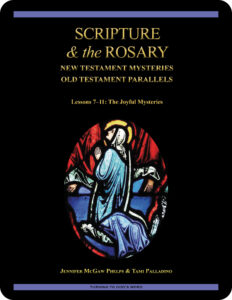 Scripture & the Rosary:
Scripture & the Rosary:
New Testament Mysteries,
Old Testament Parallels
The Second Joyful Mystery
Lesson 8 Mary Arose & Went with Haste
the Gospel According to Luke 1:39–57
the First Book of Samuel 2:1–9
Revised Standard Version Catholic Edition (RSVCE)*
New American Bible Revised Edition (NABRE)*
Catechism of the Catholic Church
Rosarium Virginis Mariae (Rosary of the Virgin Mary)
ex libris (in our library)
cross references for Scripture & the Rosary
glossary for Scripture & the Rosary
next lesson: A Decree Went Out from Caesar
This material coordinates with Lesson 8 on pages 28–31 in Scripture & the Rosary: New Testament Mysteries, Old Testament Parallels.
And Mary said, “My soul magnifies the Lord, and my spirit rejoices in God my Savior,
for he has regarded the low estate of his handmaiden.
For behold, henceforth all generations will call me blessed;
for he who is mighty has done great things for me, and holy is his name.”
—the Gospel According to Luke 1:46–49
welcome to our in-depth study of Scripture & the Rosary
We invite groups and individuals to become acquainted with Turning to God’s Word Catholic Bible  studies through
studies through  Scripture & the Rosary: New Testament Mysteries, Old Testament Parallels, which has been granted an imprimatur. Although no longer available in print, the first six lessons can be downloaded from our website. The remaining 20 lessons are posted throughout the liturgical year along with their related online study pages. Click here to access Lesson 7 through Lesson 11. If you have a Bible-related question or comment, you can contact our authors using one of the “ask us your question” or “what do you think” buttons on any online study page.
Scripture & the Rosary: New Testament Mysteries, Old Testament Parallels, which has been granted an imprimatur. Although no longer available in print, the first six lessons can be downloaded from our website. The remaining 20 lessons are posted throughout the liturgical year along with their related online study pages. Click here to access Lesson 7 through Lesson 11. If you have a Bible-related question or comment, you can contact our authors using one of the “ask us your question” or “what do you think” buttons on any online study page.
open with prayer
It’s always wise to begin any Bible study with prayer, whether reading the Scriptures alone or meeting with others in a discussion group. You can pray using your own words or use one of the opening prayers on our website. We especially like the following:
Lord Jesus, you promised to send your Holy Spirit to teach us all things.
As we read and study your word today,
allow it to touch our hearts and change our lives. Amen.
making connections—two joyful songs of praise & thanksgiving
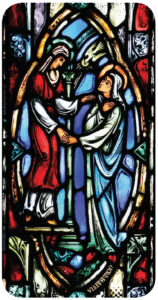 The New Testament Magnificat of the Blessed Virgin Mary frequently is compared to the Old Testament Canticle of Hannah. Both women’s songs are included in the Scripture selections for this lesson. Clicking on the New and Old Testament stained glass windows will enlarge the art. The same art illustrates Lesson 8 in Scripture & the Rosary: New Testament Mysteries, Old Testament Parallels.
The New Testament Magnificat of the Blessed Virgin Mary frequently is compared to the Old Testament Canticle of Hannah. Both women’s songs are included in the Scripture selections for this lesson. Clicking on the New and Old Testament stained glass windows will enlarge the art. The same art illustrates Lesson 8 in Scripture & the Rosary: New Testament Mysteries, Old Testament Parallels.
let’s look at the new in the light of the old
As you read through the selected passages from the New and Old Testaments, ask yourself what these two biblical accounts have in common. Additional in-depth questions can be found on pages 28–31 in Scripture & the Rosary: New Testament Mysteries, Old Testament Parallels. You can learn more about  Hannah’s experiences and the prophet Samuel’s early life in Lesson 1 The LORD Announces He Is About to Do a New Thing in the Turning to God’s Word Catholic Bible study Thus Says the LORD: God Speaks Through His Servants the Prophets—Volume I: A Kingdom Divided.
Hannah’s experiences and the prophet Samuel’s early life in Lesson 1 The LORD Announces He Is About to Do a New Thing in the Turning to God’s Word Catholic Bible study Thus Says the LORD: God Speaks Through His Servants the Prophets—Volume I: A Kingdom Divided.
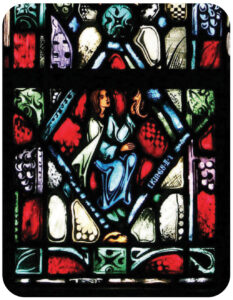 ? How are these two biblical passages similar, and how do they differ?
? How are these two biblical passages similar, and how do they differ?
? What are the specific circumstances surrounding each?
? How is God active in each situation?
? How are the roles of the Blessed Virgin Mary and Hannah similar in salvation history?
? Consider whether the Blessed Virgin Mary was influenced by knowing Hannah’s canticle.
? Which verses in Hannah’s canticle might be interpreted as pointing ahead to the birth of a Messiah?
 ? Look at the pictures of the stained glass window on pages 28 and 30 in Scripture & the Rosary: New Testament Mysteries, Old Testament Parallels. What similarities can be seen between these depictions of the New and Old Testament scenes related to the Second Joyful Mystery?
? Look at the pictures of the stained glass window on pages 28 and 30 in Scripture & the Rosary: New Testament Mysteries, Old Testament Parallels. What similarities can be seen between these depictions of the New and Old Testament scenes related to the Second Joyful Mystery?
supplemental Scripture
The New Testament text is taken from the Gospel According to Luke 1:39–57 and is the source of two  much-loved Marian prayers. The Old Testament parallel continues the story of Hannah receiving a long-awaited son. The First Book of Samuel 2:1–10 covers Hannah’s canticle, which is recognized as a foreshadowing of the Blessed Virgin Mary’s Magnificat. For additional background about Samuel’s anointing of the first two kings of Israel (Saul and David), read the First Book of Samuel 3:19—16:13 and check out the related Turning to God’s Word Catholic Bible study The United Kingdom of Israel: Saul, David & Solomon Foreshadow Christ the King.
much-loved Marian prayers. The Old Testament parallel continues the story of Hannah receiving a long-awaited son. The First Book of Samuel 2:1–10 covers Hannah’s canticle, which is recognized as a foreshadowing of the Blessed Virgin Mary’s Magnificat. For additional background about Samuel’s anointing of the first two kings of Israel (Saul and David), read the First Book of Samuel 3:19—16:13 and check out the related Turning to God’s Word Catholic Bible study The United Kingdom of Israel: Saul, David & Solomon Foreshadow Christ the King.
ex libris—a book that links Jesus & his cousin John
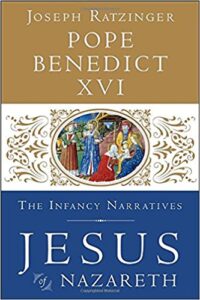
 Jesus of Nazareth: The Infancy Narratives is the last book in a three-part series about Jesus in the Gospels by Pope Benedict XVI. Focusing on Scripture, this relatively short work examines the infancy narratives found in the Gospels According to Matthew and Luke, and when relevant looks at the Gospel According to John. Read excerpts and learn more about the Jesus of Nazareth trilogy and other works related to Bible study at ex libris—main bookshelf.
Jesus of Nazareth: The Infancy Narratives is the last book in a three-part series about Jesus in the Gospels by Pope Benedict XVI. Focusing on Scripture, this relatively short work examines the infancy narratives found in the Gospels According to Matthew and Luke, and when relevant looks at the Gospel According to John. Read excerpts and learn more about the Jesus of Nazareth trilogy and other works related to Bible study at ex libris—main bookshelf.
“In the first place, the annunciation of the birth of Jesus is linked chronologically with the story of John the Baptist by the reference to the time that has elapsed since the archangel  Gabriel’s message to Zechariah, that is to say “in the sixth month” of Elizabeth’s pregnancy. The two events and the two missions are also linked in this passage by the indication that Mary and Elizabeth, and hence their offspring too, are blood relatives.
Gabriel’s message to Zechariah, that is to say “in the sixth month” of Elizabeth’s pregnancy. The two events and the two missions are also linked in this passage by the indication that Mary and Elizabeth, and hence their offspring too, are blood relatives.
“Mary’s visit to Elizabeth, made as a consequence of the dialogue between Gabriel and Mary [the Gospel According to Luke 1:36], occasions an encounter in the Holy Spirit between Jesus and John even before they are born, and this encounter at the same time makes visible the relationship between their respective missions: Jesus is the younger of the two, the one who comes later. But he is the one whose proximity causes John to leap in his mother’s womb and fills Elizabeth with the Holy Spirit [the Gospel According to Luke 1:41].”
sharing moments of joy
The close relationship between the Blessed Virgin Mary and her cousin Elizabeth sets the stage for the interaction of Jesus and his cousin, called John the Baptist in the synoptic Gospels According to Matthew, Mark, and Luke. The adult roles these infants will play are foreshadowed when, at the sound of Mary’s voice, the child in Elizabeth’s womb leaps for joy. In that culture, children always were viewed as a blessing. Elizabeth’s unexpected pregnancy, after she had been presumed barren for years, would have been received with great joy. Mary’s pregnancy, on the other hand, was problematic because she was unmarried. It’s striking that the child in Elizabeth’s womb is able to recognize the presence of the Son of God. It’s also striking that Elizabeth is able to recognize the particular blessing connected with Mary’s pregnancy and to express wonder at what it means. Elizabeth’s joyful acknowledgment of the significance of the child that Mary is carrying must have been of great comfort to Mary.
WHAT DO YOU THINK about the place of joy in your life?
Consider why Scripture refers more often to joy than it does to happiness. Some translations of the New Testament Beatitudes substitute the word “happy” or “happiness” for “blessed” or “blessedness.” For more information, see the entry on blessed in the Lost in Translation archives.
 ? What are the most joyful events that have occurred in your life?
? What are the most joyful events that have occurred in your life?
? With whom did you share your joy?
? How was God at work in those events?
? What’s the most joyful thing that’s occurred in your spiritual life?
? When was the last time that you shared the joy of your faith with someone else?
? How might joy and blessedness be related?
? What is suggested by substituting blessedness for happiness?
? Consider what’s the major difference between joy and happiness.
 magnify—you could look it up in our archives
magnify—you could look it up in our archives
In her Magnificat in the Gospel According to Luke 1:46–55, the Blessed Virgin sings of magnifying the Lord. To learn about the challenges posed by rendering her words into English, read Lost in Translation, an online column in which Turning to God’s Word author Matthew Phelps helps readers connect with ideas expressed in the original languages of the Scriptures. New Lost in Translation entries are posted on Mondays, and past entries are archived on our website. Contact us if you’d like to receive Lost in Translation by email every week.
do you know the spiritual fruit associated with the Second Joyful Mystery?
Hint: It appears in direct opposition to self-centered behavior. You can find out what it is in the “Fruits of Prayer” box on page 29 in Scripture & the Rosary: New Testament Mysteries, Old Testament Parallels. In what ways might this fruit benefit you in your everyday life?
the best Catholic commentary about Scripture
 To find out more about how Church teaching is supported by passages in Scripture & the Rosary: New Testament Mysteries, Old Testament Parallels, check out the Index of Citations in the Catechism of the Catholic Church. Links to the primary Scripture passages in the lesson (Revised Standard Version Catholic Edition [RSVCE*]) and relevant paragraphs in the Catechism are provided here. Not every passage in the biblical text for this study is referenced in a Catechism paragraph, however, including the passage in this lesson from the First Book of Samuel 2:1–9.
To find out more about how Church teaching is supported by passages in Scripture & the Rosary: New Testament Mysteries, Old Testament Parallels, check out the Index of Citations in the Catechism of the Catholic Church. Links to the primary Scripture passages in the lesson (Revised Standard Version Catholic Edition [RSVCE*]) and relevant paragraphs in the Catechism are provided here. Not every passage in the biblical text for this study is referenced in a Catechism paragraph, however, including the passage in this lesson from the First Book of Samuel 2:1–9.
the Gospel According to Luke 1:41—paragraphs 523, 717, 2676
the Gospel According to Luke 1:43—paragraphs 448, 495, 2677
the Gospel According to Luke 1:45—paragraphs 148, 2676
the Gospel According to Luke 1:46–49—paragraph 2097
the Gospel According to Luke 1:46–55—paragraphs 722, 2619, 2675
the Gospel According to Luke 1:48—paragraphs 148, 971, 2676
the Gospel According to Luke 1:49—paragraphs 273, 2599, 2807, 2827
the Gospel According to Luke 1:50—paragraph 2465
the Gospel According to Luke 1:54–55—paragraph 706
the Gospel According to Luke 1:55—paragraph 422
ways our glossary might prove helpful
In addition to providing extra information about geographical locations, our glossary also points out  when a person or place is mentioned in the biblical text under more than one name or more than one spelling. If you can remember a name but aren’t sure in which lesson it shows up, you can find it in the glossary, which lists every proper noun that appears in the primary biblical text in Scripture & the Rosary: New Testament Mysteries, Old Testament Parallels.
when a person or place is mentioned in the biblical text under more than one name or more than one spelling. If you can remember a name but aren’t sure in which lesson it shows up, you can find it in the glossary, which lists every proper noun that appears in the primary biblical text in Scripture & the Rosary: New Testament Mysteries, Old Testament Parallels.
to learn more, read more Scripture
When you’re having difficulty understanding a passage of Scripture, it can help to read the  cross references—but looking these up takes time. We’ve compiled the cross references from the Revised Standard Version Second Catholic Edition (RSV2CE)—the same translation that we reprint in our study books. The list can be found at the top of every online study page, and it includes links to cross references in the primary biblical texts for all of the lessons in Scripture & the Rosary: New Testament Mysteries, Old Testament Parallels.
cross references—but looking these up takes time. We’ve compiled the cross references from the Revised Standard Version Second Catholic Edition (RSV2CE)—the same translation that we reprint in our study books. The list can be found at the top of every online study page, and it includes links to cross references in the primary biblical texts for all of the lessons in Scripture & the Rosary: New Testament Mysteries, Old Testament Parallels.
don’t forget about our indexes & extra online material

 If you’re trying to locate information about a Scripture passage, you can look it up in the index at the back of the online version of this study. If you want to revisit a commentary, you can look it up by title in the topics index. If you want to learn more about another book of the Bible for which there’s a Turning to God’s Word study, you can read online commentaries and watch any accompanying videos by choosing a lesson from one of the study directories. (There are no lesson videos with Scripture & the Rosary: New Testament Mysteries, Old Testament Parallels.) Finally, if you have a question or would like to make a comment about any of our studies, you can use the “ask us your question” or “what do you think” button to email our authors.
If you’re trying to locate information about a Scripture passage, you can look it up in the index at the back of the online version of this study. If you want to revisit a commentary, you can look it up by title in the topics index. If you want to learn more about another book of the Bible for which there’s a Turning to God’s Word study, you can read online commentaries and watch any accompanying videos by choosing a lesson from one of the study directories. (There are no lesson videos with Scripture & the Rosary: New Testament Mysteries, Old Testament Parallels.) Finally, if you have a question or would like to make a comment about any of our studies, you can use the “ask us your question” or “what do you think” button to email our authors.
ex libris—Church documents & books about religious topics
Link to magisterial documents referred to in our Bible studies at ex libris—magisterial documents.  This listing includes significant recent encyclicals as well as a number of historical Church documents. Recommended books related to Scripture study can be found at ex libris—main bookshelf.
This listing includes significant recent encyclicals as well as a number of historical Church documents. Recommended books related to Scripture study can be found at ex libris—main bookshelf.
wondering how to pronounce some of these words?
The following links are to readings from the New International Version (NIV) Bible. To listen, click on the audio icon above the printed text. Although not taken from the translations used in our study materials, the NIV readings provide an audio guide to pronunciation of words in this lesson’s primary biblical texts. A close online version of the translation of the Bible used in Catholic liturgy in the United States as well as an audio guide for daily Mass readings for the current month can be found on the website of the United States Conference of Catholic Bishops (USCCB).
the Gospel According to Luke 1:39–57 (NIV)
the First Book of Samuel 2:1–9 (NIV)
close by praying the Second Joyful Mystery
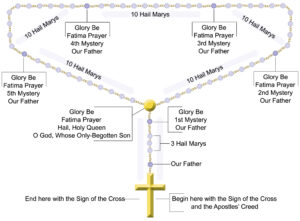 Many of our study groups like to conclude discussions of Scripture & the Rosary: New Testament Mysteries, Old Testament Parallels by praying a decade of the Rosary devoted to the Mystery that’s the focus of their lesson. A number of Catholics include a request for an increase in the spiritual fruit associated with the mystery. You can find out what’s associated with the Second Joyful Mystery in the “Fruits of Prayer” box on page 29 in Scripture & the Rosary: New Testament Mysteries, Old Testament Parallels.
Many of our study groups like to conclude discussions of Scripture & the Rosary: New Testament Mysteries, Old Testament Parallels by praying a decade of the Rosary devoted to the Mystery that’s the focus of their lesson. A number of Catholics include a request for an increase in the spiritual fruit associated with the mystery. You can find out what’s associated with the Second Joyful Mystery in the “Fruits of Prayer” box on page 29 in Scripture & the Rosary: New Testament Mysteries, Old Testament Parallels.
 We invite you to pray along with Turning to God’s Word co-founder Tami Palladino and her daughter Anne Marie on their prayer video featuring the Second Joyful Mystery of the Rosary. The prayers and videos for all 20 mysteries are accessible year-round at how to pray the Rosary, and you can access a link to Tami and Anne Marie’s how-to video to learn what’s important about praying the Rosary. Clicking on the diagram (above) will take you to the website page with the Rosary prayers.
We invite you to pray along with Turning to God’s Word co-founder Tami Palladino and her daughter Anne Marie on their prayer video featuring the Second Joyful Mystery of the Rosary. The prayers and videos for all 20 mysteries are accessible year-round at how to pray the Rosary, and you can access a link to Tami and Anne Marie’s how-to video to learn what’s important about praying the Rosary. Clicking on the diagram (above) will take you to the website page with the Rosary prayers.
Lesson 9 A Decree Went Out from Caesar (the Third Joyful Mystery, the Nativity)—the Gospel According to Luke 2:1–12 and the First Book of Samuel 1:19–23
Lesson 7 The Angel Gabriel Was Sent to a Virgin (the First Joyful Mystery, the Annunciation)—the Gospel According to Luke 1:26–35 and the First Book of Samuel 1:9–17
you also may like our two-part study of the prophets
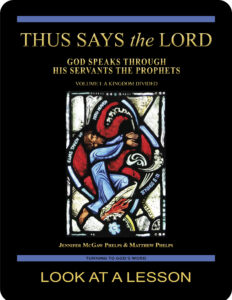
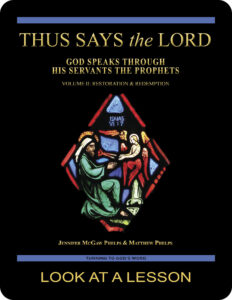 Thus Says the LORD: God Speaks Through His Servants the Prophets—Volume I: A Kingdom Divided examines the prophets in their historical context using the First and Second Books of the Kings and other Old Testament passages written before the Babylonian Exile in 586 B.C. Volume II: Restoration & Redemption looks at the post-exilic prophets. This 51-lesson Catholic Bible study builds on The United Kingdom of Israel: Saul, David & Solomon Foreshadow Christ the King. Click on the books’ covers to view a sample lesson from each volume.
Thus Says the LORD: God Speaks Through His Servants the Prophets—Volume I: A Kingdom Divided examines the prophets in their historical context using the First and Second Books of the Kings and other Old Testament passages written before the Babylonian Exile in 586 B.C. Volume II: Restoration & Redemption looks at the post-exilic prophets. This 51-lesson Catholic Bible study builds on The United Kingdom of Israel: Saul, David & Solomon Foreshadow Christ the King. Click on the books’ covers to view a sample lesson from each volume.
start a Turning to God’s Word Bible study
Thank you for your interest in Scripture & the Rosary: New Testament Mysteries, Old Testament Parallels. 
 Information about beginning a Turning to God’s Word Bible study can be found at start a Bible study. Tami, Matthew, and I are available to answer your questions and to offer support. You may use this email to contact us directly if you’re interested in starting a Turning to God study or in having your study schedule listed with other TtGW study groups on our website. —Jennifer
Information about beginning a Turning to God’s Word Bible study can be found at start a Bible study. Tami, Matthew, and I are available to answer your questions and to offer support. You may use this email to contact us directly if you’re interested in starting a Turning to God study or in having your study schedule listed with other TtGW study groups on our website. —Jennifer
*There are seven deuterocanonical books in the Old Testament—the Books of Tobit, Judith, Wisdom, Sirach, Baruch, and First and Second Maccabees, as well as some passages in the Books of Esther and Daniel. Protestants usually refer to these works as “apocryphal,” a word that means “outside the (Protestant) canon” because they’re excluded from most Protestant Bibles. The word “deuterocanonical” means “second canon”; Catholics use that word to refer to any section of the Catholic Old Testament for which there are no extant, or existing, Hebrew manuscripts. All of the deuterocanonical books appear in the Septuagint, the earliest remaining versions of which date to the 1st century B.C. This Greek translation of the Old Testament was in common use by Jews at the time of Jesus. Learn more by reading How Do Catholic & Protestant Bibles Differ?
Turning to God’s Word printed Bible studies use the 2006 Revised Standard Version Second Catholic Edition (RSV2CE) translation for all Scripture references except those to the Psalms, which are taken from The Abbey Psalms and Canticles, prepared by the Benedictine monks of Conception Abbey and published in 2020 by the United States Conference of Catholic Bishops (USCCB). All Scripture links for the digital version of Scripture & the Rosary: New Testament Mysteries, Old Testament Parallels are to the 1966 Revised Standard Version Catholic Edition (RSVCE) translation. The New International Version (NIV) audio recordings follow the same chapter and verse numbering as the RSV Catholic translations, but the NIV translation doesn’t include the deuterocanonical books and passages.
The 1966 RSVCE uses archaic pronouns and verb forms such as “thee,” “thou,” “didst” in the Psalms and in direct quotations attributed to God. The 2006 RSV2CE replaces these with more accessible English. The few significant translation changes in the RSV2CE include rendering almah as “virgin” in the Book of Isaiah 7:14 and restoring the term “begotten” in the Gospel According to John 3:16.
Numbering varies for some passages in this Bible study. Turning to God’s Word studies follow the numbering in the Revised Standard Version Catholic translations (RSV2CE and RSVCE). Discrepancies in the New American Bible Revised Edition (NABRE) are noted in the Index of Scripture Citations.
 You can learn more about the Psalms by viewing a sample lesson from the Turning to God’s Word Catholic Bible study Sing a New Psalm: Communicating with God Through the Prayers of the Church—Volume I: Lauds & Vespers. The second part of that study, Sing a New Psalm: Communicating with God Through the Prayers of the Church—Volume II: Vigils, Day Prayer & Compline, is scheduled for publication in 2025. Some verse numbers may vary in different translations of the Psalms.
You can learn more about the Psalms by viewing a sample lesson from the Turning to God’s Word Catholic Bible study Sing a New Psalm: Communicating with God Through the Prayers of the Church—Volume I: Lauds & Vespers. The second part of that study, Sing a New Psalm: Communicating with God Through the Prayers of the Church—Volume II: Vigils, Day Prayer & Compline, is scheduled for publication in 2025. Some verse numbers may vary in different translations of the Psalms.
